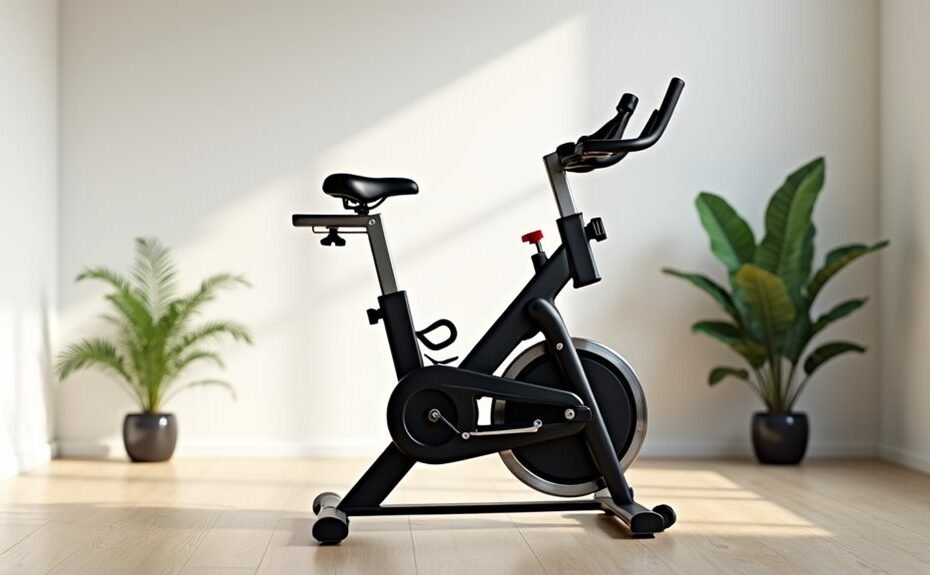While you might think static bikes are just another piece of gym equipment collecting dust, I've discovered they're actually a gateway to transforming your posture and overall body alignment. What sets them apart isn't just the cardiovascular benefits or calorie burn – it's their unique ability to strengthen your core and create muscle memory for proper posture, all while being gentle on your joints. I'll show you how this seemingly simple piece of equipment holds the key to standing taller, feeling stronger, and moving with confidence throughout your day.
Key Takeaways
- Proper bike setup with saddle height aligned to hip bone ensures optimal posture and prevents strain during workouts.
- Engaging core muscles while cycling stabilizes the spine and promotes better posture both on and off the bike.
- Regular static cycling strengthens lower body muscles, creating a balanced foundation for improved overall posture.
- Low-impact nature of static bikes allows consistent training without joint stress, supporting long-term posture improvement.
- Combining static cycling with daily posture exercises like wall angels and planks maximizes postural benefits.
The Science Behind Posture
Despite common beliefs that poor posture directly causes pain, recent scientific evidence tells a different story. I'll be blunt: that hunched back you're worried about? It's probably not the source of your discomfort. Research shows no significant correlation between awkward postures and pain, and those leg length differences you've been stressing over don't increase back pain risk either.
Here's what actually matters: it's not the position, it's the persistence. I'm talking about staying in one position too long – that's your real enemy. Upright bikes provide an excellent way to combat sedentary behavior by engaging multiple muscle groups and promoting dynamic movement. Think about it: your body's built for movement, not statue impersonations. Even if you're hitting the gym regularly, prolonged sitting can still wreak havoc on your health. Those "perfect posture" myths? They're mostly marketing. Sedentary behavior significantly increases your risk of developing chronic lower back pain. Good metabolic health through regular movement and activity is more important than achieving perfect posture.
What does affect your posture? Everything from your phone habits to your sleep position plays a role.
Weak core muscles, inflexible joints, and medical conditions like osteoporosis can throw your alignment off. But remember – correlation isn't causation. The key isn't achieving some idealized posture; it's about keeping your body moving and adaptable.
Core Muscles and Back Support
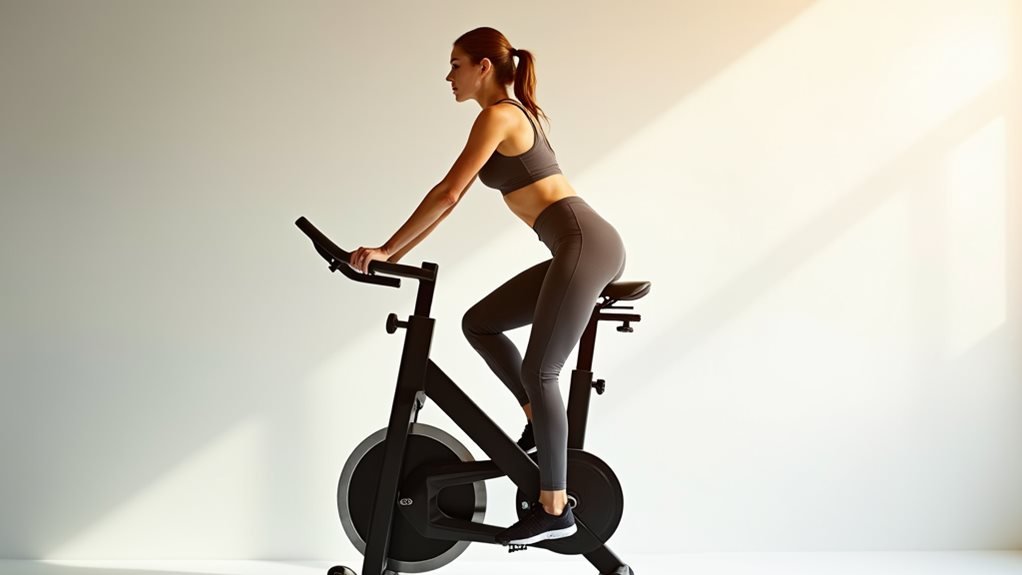
Now that we understand posture isn't about perfection, let's focus on what actually powers your cycling form: your core and back muscles. Think of your core as mission control – it's not just there for show. When you're cycling, it's actively stabilizing your body, especially during those moments you're cranking up the resistance or rising from the saddle.
Your back muscles aren't playing a primary role either. They're working overtime to keep your spine aligned and your upper body stable. This is particularly important for desk job workers who need to counteract prolonged sitting. Air bike workouts can specifically target these muscle groups, providing comprehensive engagement for improved posture and stability.
I'll let you in on a secret: most cycling injuries stem from weak core and back muscles, not from the legs. That's why I'm insistent about proper alignment – neutral spine, relaxed shoulders, and precise knee positioning over the ball of your foot. The proper bike setup ensures you'll maintain optimal muscle recruitment throughout your ride.
Here's the payoff: when you consistently engage these muscle groups, you're not just improving your cycling form. You're building a foundation for better posture off the bike, reducing back pain, and enhancing overall stability. Trust me, your future self will thank you for taking the time to strengthen these essential muscle groups now.
Standing Versus Seated Positions
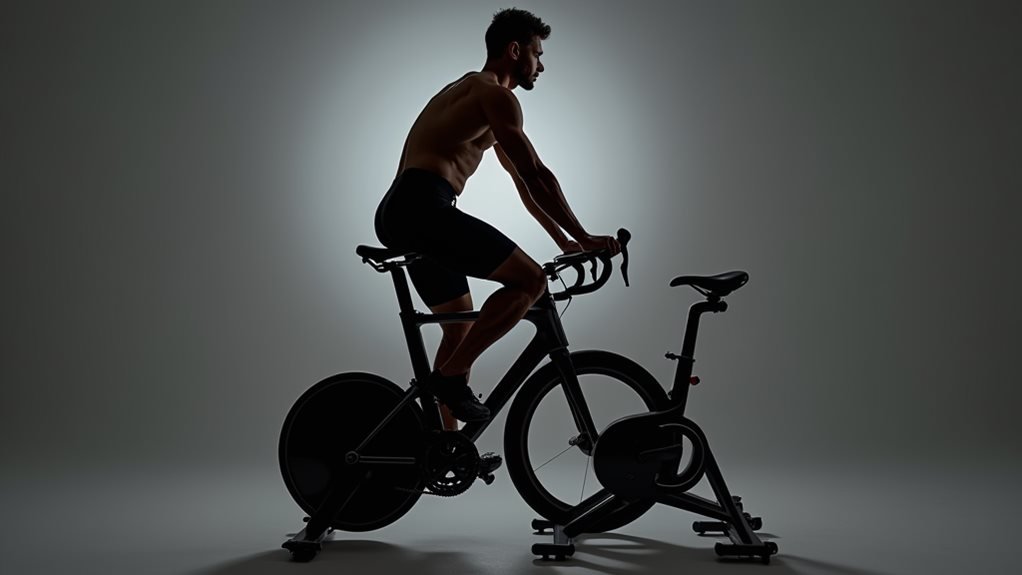
Riders often debate the merits of standing versus seated positions on static bikes, and I'll tell you why both matter.
When you're standing, you're engaging more muscle groups – we're talking core, glutes, and upper body all joining the party. It's like getting a full-body workout while your heart rate climbs an extra 8 beats per minute. Your power transfer efficiency significantly increases in the standing position. Alternating between standing and seated creates a varied intensity workout. Air resistance bikes can amplify this muscle engagement even further.
Here's the kicker: while standing burns more calories per minute, you can't maintain it forever. That's where seated cycling becomes your best friend.
It's your steady-state cardio champion, letting you ride longer while keeping your joints happy. Trust me, your knees will thank you.
I'm going to be straight with you – if you've got joint issues or lower back problems, stick to seated cycling most of the time. But if you're looking to blast through a high-intensity workout, get out of that saddle.
Just remember: form is everything when you're standing. I see too many riders compromising their posture for intensity. The sweet spot? Alternate between positions.
You'll get the best of both worlds while keeping your body balanced and strong.
Perfect Your Riding Form
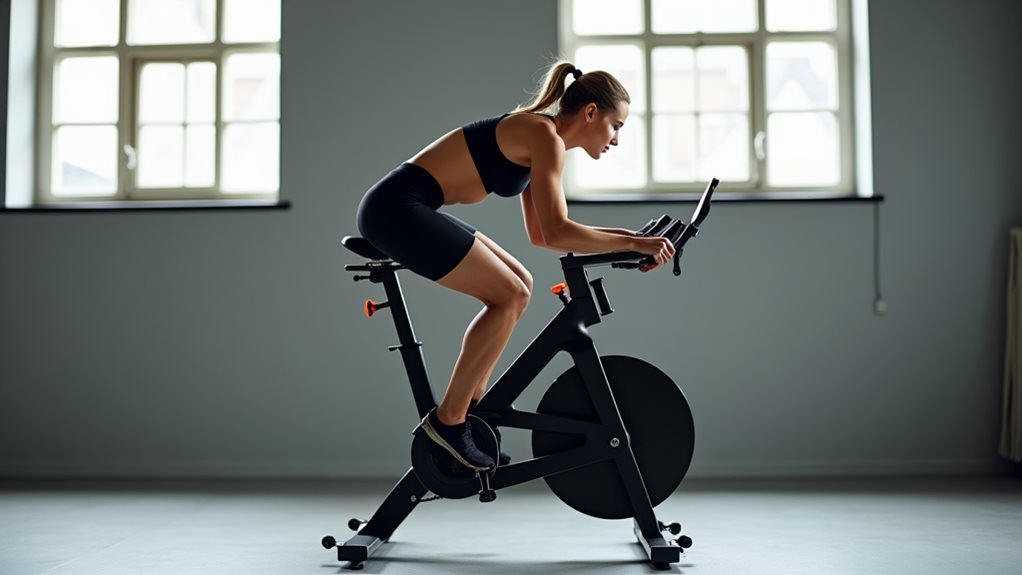
Getting your riding form right can make the difference between an effective workout and potential injury. I'll walk you through the essentials of proper form that'll transform your ride from mediocre to magnificent.
Let's start with your saddle height – it should align with your hip bone when you're standing next to the bike. Once you're seated, you'll want a slight bend in your knee (5-10 degrees) at the bottom of your pedal stroke. Trust me, your knees will thank you later. Screen at eye level will help prevent neck strain during your ride.
Now, here's the position that trips up most riders: your knees should align directly over the balls of your feet when the pedals are at 3 and 9 o'clock. I can't stress enough how vital this alignment is for preventing joint stress. Remember to maintain equal foot pressure throughout your pedaling motion to avoid strain and maintain proper alignment.
Your handlebars? They're not just for show. Position them at saddle height or slightly higher – we're not training for the Tour de France here.
Keep your spine neutral, shoulders relaxed, and core engaged. Think of yourself as a well-oiled machine: everything should move smoothly, efficiently, and in perfect harmony.
Joint Health While Cycling
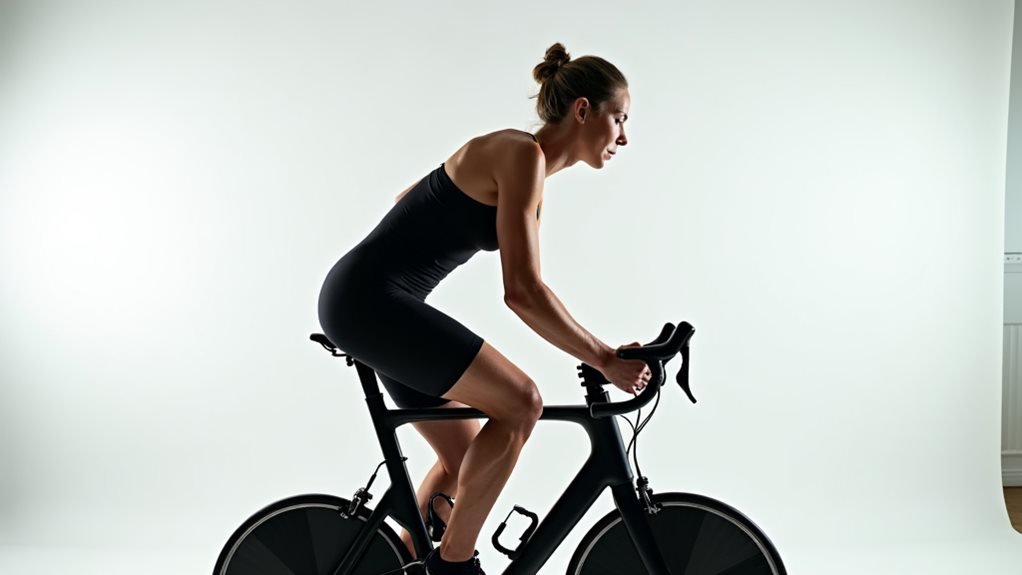
While mastering proper form sets the foundation for your cycling journey, understanding how cycling impacts your joints can help you maintain a sustainable fitness routine.
I'll tell you straight: static bikes are your joints' best friend. They deliver all the cardiovascular benefits you need without hammering your knees into submission. For those seeking improved hip osteoarthritis, stationary biking has shown significant positive outcomes. Core strength increases naturally as you maintain proper posture during rides.
Here's what's happening while you pedal: you're producing synovial fluid – nature's own joint lubricant. It's like giving your joints an oil change with every session. The smooth, circular motion strengthens the muscles around your knees, hips, and ankles without the jarring impact you'd get from running.
Let's talk benefits. You're building strength in your quads, hamstrings, and calves – the holy trinity of knee support. This muscle development isn't just for show; it's creating a natural brace system for your joints. And if you're dealing with arthritis or recovering from an injury, you'll love this: the low-impact nature means you can keep exercising without aggravating your condition. Trust me, your joints will thank you later.
Daily Exercise for Better Posture
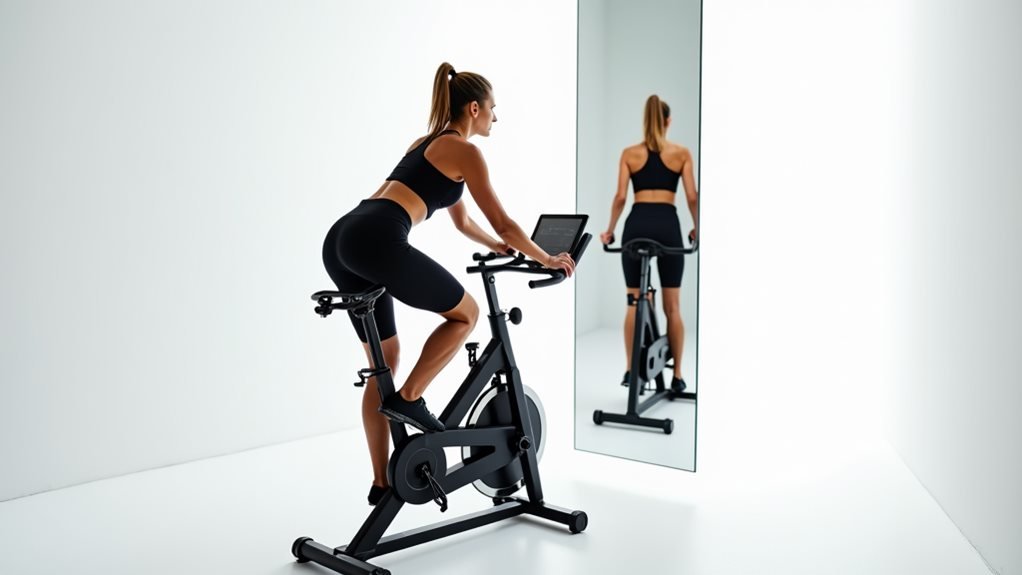
Posture doesn't just happen – it's built through deliberate daily movement. I'll tell you exactly what to do to transform your slouch into strength, starting with your core foundation.
Begin your morning with wall angels – they're like snow angels but vertical and infinitely more useful for your posture. Pair these with shoulder blade squeezes, and you'll feel your upper back awakening from its keyboard-induced slumber.
When you're tight from riding, hit the floor for some cobra poses and cat-cow stretches – they're your spine's best friends.
Don't neglect your lower body. Glute bridges are non-negotiable; weak glutes are posture killers. Throw in some kneeling hip flexor stretches to combat those hours of sitting, and you'll notice immediate relief.
For thoracic mobility (that's your upper back, folks), quadruped extensions are pure gold.
Common Posture Problems and Solutions
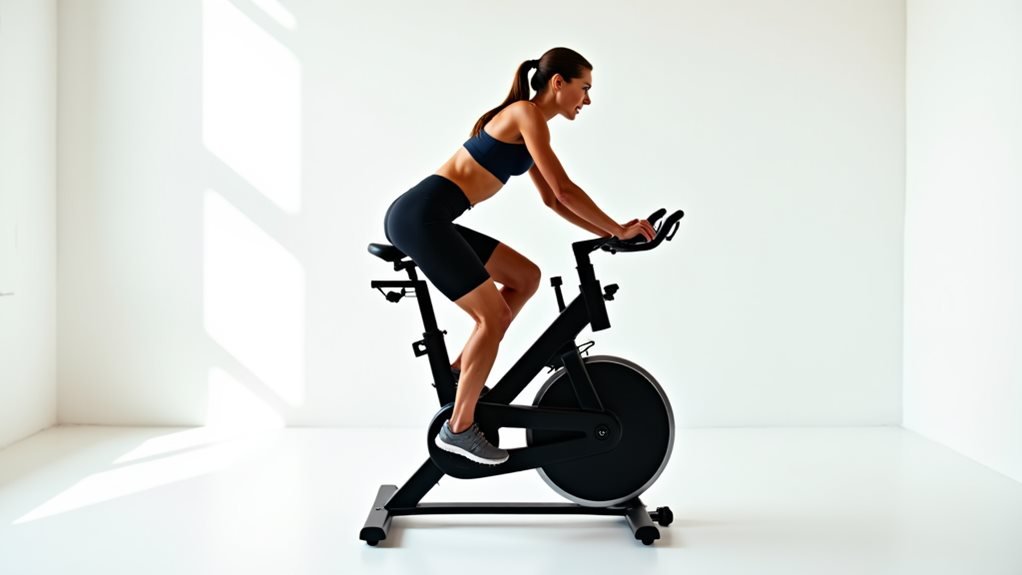
Let's explore the most common posture problems I see in my clients. Trust me, they're predictable – over-pronated feet turning outward, anterior pelvic tilt from too much sitting, and that dreaded desk-worker hunchback. I've seen it all, and I know how to fix it.
Here's what's happening: Your feet aren't just flat, they're crying for help. Those collapsed arches are throwing your entire body out of whack.
Your hips? They're tilting forward because your hip flexors are basically cement from sitting all day.
And that upper back curve? It's screaming "I spend too much time hunched over devices!"
The solutions aren't complicated, but they require commitment. Start with custom orthotics for those feet and daily calf raises.
For your tilted pelvis, stretch those hip flexors and wake up those sleeping glutes with bridges and squats.
Fighting the hunchback? You'll need doorway stretches and face pulls.
Don't forget the core – it's your postural powerhouse. Think planks, bird-dogs, and leg raises. Your body's alignment is a chain reaction – fix one link, and the rest will follow.
Frequently Asked Questions
How Long Should Beginners Spend on a Static Bike per Session?
Want to start your cycling journey right? I recommend you begin with 15-20 minute sessions, 3-5 days weekly. You'll build endurance gradually, working up to longer rides as you progress.
Can Static Cycling Help Reduce Lower Back Pain From Desk Jobs?
I'll tell you static cycling can help relieve desk-related back pain when done correctly. It strengthens core muscles, improves posture, and creates movement patterns that counter prolonged sitting's negative effects.
Should I Wear Special Shoes When Using a Stationary Bike?
I strongly recommend using cycling shoes for stationary bikes. They'll improve your pedaling efficiency, prevent foot slippage, reduce injury risk, and enhance power transfer. Plus, they'll keep your feet comfortable during workouts.
Does Cycling on a Static Bike Cause Muscle Imbalances Over Time?
Yes, I'll warn you that static cycling can create muscle imbalances – especially in your quads, hip flexors, and upper body – unless you balance it with cross-training and targeted strength exercises.
What Stretches Should I Do Before and After Static Bike Workouts?
I recommend dynamic stretches like leg swings and hip circles before riding, then static stretches targeting your quads, hamstrings, calves, and hip flexors after your workout's done.
